|
Fai click qui
per leggere la versione italiana
"Hello? Is that xxx yyy music shop?"
"Yes, good evening. Can I help you?"
"Hi, listen, I was looking for a second hand saxophone."
"Look, we only have a contralto available at the moment."
"No, no, I was looking for a sax."
At this point, the shop
assistant, who had understood who he was talking to, hissed:
“Exactly, a contralto sax, come and
have a look at it”.
I was 14 at the time and
eventually went to see and bought a contralto for which the definition "band
instrument" would have been a compliment.
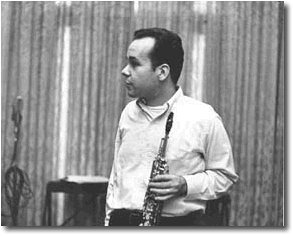 Anyway,
it did not last long, after a couple of years I got a soprano and I practically
learnt to play on it. Anyway,
it did not last long, after a couple of years I got a soprano and I practically
learnt to play on it.
The idea of a soprano came to me after seeing, and listening to, Steve
Lacy in concert: I was totally bewitched by him, by the instrument and by
the sound that came out of it.
This story is intended, above all, as a modest homage to a great
jazzman, but since his importance is little known and appreciated, it is also a
humble attempt at making him better known.
Steve Lacy, whose real name was Steven Lakritz, was born in New York
on July 23rd 1934.
Steve has always played the soprano with absolute devotion, so as to
inspire, as the story goes, John Coltrane (and later many other musicians) in
the strange use (for the times) of this instrument as second saxophone.
His devotion has translated into unreachable perfection in terms of
timbre and tuning and, as we shall see, into an absolutely peculiar style.
Steve's sound is "thick", substantial and lyrical at the same time.
Let's listen to an extract from the theme presentation of
Paris Blues,
where he plays with Gil Evans (Paris Blues, Owl Records: R2-79247 - 1988),
a record I particularly love because of its dreamlike atmosphere.
Paris
blues MP3
93KB ( ) )
In this record, Steve’s
sound keeps carrying a breath of air that makes it even more intense.
And now let’s listen to the end of the theme of Reincarnation of a Lovebird
(Charles Mingus) and to
the beginning of the solo.
Reincarnation
of a Lovebird MP3
43KB ( ) )
Intonation is always a
torture for soprano players, but Steve does not have this kind of problems.
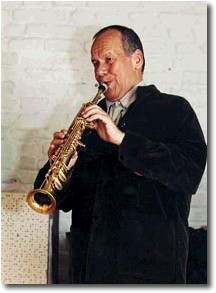 Let's
listen to Esteem
(Steve Lacy), a composition of his own in which he starts as if he were tuning
his instrument and at the end he "grabs" a (real) very high D, which is
not easy on a soprano. Let's
listen to Esteem
(Steve Lacy), a composition of his own in which he starts as if he were tuning
his instrument and at the end he "grabs" a (real) very high D, which is
not easy on a soprano.
Esteem
MP3 78KB ( ) )
Now that introductions
are over, let’s try and talk about style.
From these first extracts it is quite evident that Steve has a very
personal view of style.
In very few musicians the musical and the spiritual dimensions blend as
they do in him. His way of playing has always been consistent with his
personality, that is why I have decided to tell this story backwards starting
from his artistic maturity.
Steve's stylistic development is very peculiar: he starts with
Dixieland and moves straight on to "creative" or free music starting
a fundamental collaboration with Cecil Taylor (New York, 3/15/1929).
Also his steady collaboration with Gil Evans (Ian Ernest Gilmore Green: Toronto, Ontario, Canada,
5/13/1912
- Cuernavaca, Mexico, 3/20/1988) from the beginning of his career is very
important and fruitful.
He reinterprets Bop in a deeper way, without letting himself be
caught by its hyper-technical aspects but taking in its emotional and creative
approach.
For this reason he has always played Monk (piano, Thelonious Sphere Monk: Rocky Mount, 10 ottobre 1917 -
Weehawken, 17 febbraio 1982) and played "with" Monk for several months in 1960,
becoming, in my opinion, one of the interpreters who got conceptually closer to
the creative dimension of this pianist.
As a proof of this, listen to the
Evidence
solo from the beautiful record (Prestige/New Jazz OJC 1755,
1961)
carrying the same title in which he plays with Don Cherry (trumpet, Donald Eugene Cherry: Oklahoma City,
11/18/1936
- Malaga, Spain, 10/19/1995), Carl Brown (double bass) and the late, and
great, Billy Higgins (drums, Los
Angeles, 10/11/1936 - Inglewood, 5/3/2001).
Evidence
MP3 218KB ( ) )
Before going on, I would
like to spend a few words on the exceptional rhythmic section of this
record.
The solidity and swing of the Brown - Higgins duo are stupefying.
Notice that Billy Higgins does not touch his toms for the whole solo and
dialogues with the leader using his roll and always looking for the finishing
touch.
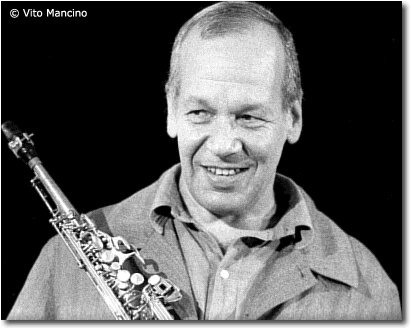 I'm
not trying to steal anybody’s job but, especially while listening to Lacy, the
percussion specialists of Jazzitalia should not give in to the temptation of
listening only to their instrument and should pay attention to all the shades of
the interplay between the musicians. I'm
not trying to steal anybody’s job but, especially while listening to Lacy, the
percussion specialists of Jazzitalia should not give in to the temptation of
listening only to their instrument and should pay attention to all the shades of
the interplay between the musicians.
Going back to Lacy, this solo perfectly shows his idea of style.
He will never play Parker-like, Coltrane-like or Rollins-like.
His notes are "heavy", they are always meaningful, and so are his pauses,
he never plays a phrase just for the sake of it. He is always in search of a
personal, and consequently universal language, free from any cultural mannerisms.
He shows a natural desire not to sound like anybody but to express his own
interiority, without any compromise, and this makes him very similar to Monk.
Notice the beginning of the solo, its long notes never rhythmically the
same, shifting to produce a sense of swing.
The logic of his phrases is disarming, it melodically and rhythmically
rides the time, in a transversal way, apparently ignoring it, but in fact
skilfully interpreting it and bending it to his own expressive ends.
The rhythmic part is never a simple "swinging metronome" but is an
essential component to be entered in relation with.
He phrases on the very high notes with unusual lightness and
mastery.
In his solos, the theme is always there and from time to time it surfaces
more or less evidently, rhythmically modified and/or translated, like at the end
of the solo.
At this point I’m afraid I should give a definition of Steve's style.
But it's a no easy task.
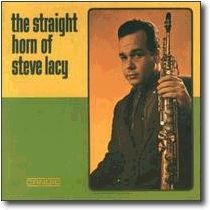 It
is neither bop, nor cool, nor modal, then it’s free! Not even that. He plays in
his own way. Could we call it "melodic free"? It
is neither bop, nor cool, nor modal, then it’s free! Not even that. He plays in
his own way. Could we call it "melodic free"?
No, I don't like this
definition either. I'd better give up. I own my incompetence, you decide, and to
help you, here is a fragment of solo on Air,
a piece by Cecil Taylor from The Straight Horn of Steve Lacy (Candid
8007, 1961),
with
Charles Davis (baritono sax, Goodman, MI, 5/20/1933), John
Ore (double bass, 12/17/1933) and Roy Haynes (drums, Roy Owen Haynes:
Roxbury, MA, 5/13/1926).
I included the end of Charles Davis's solo to emphasize the contrast
between his bop phrasing and the leader's more personal one.
Air
MP3 127KB ( ) )
A very personal chords
and rhythm interpretation interpretation and absolutely original, with relax and
without common phrases, not even those tipical of "free jazz".
He seems to be trying to set free from the chains of the tonal system and of
the metrics without denying the importance of melody and lyricism, two elements
he can't do without.
It is obvious that his idea of melody and catchiness changes according to
various factors, mainly the cultural (and consequently structural) ones
mentioned by other critics.
For this reason, Lacy's latest production is surprising because he gets
much closer to free jazz than we are used to.
The difference is that in him this conclusion is the natural evolution of
a consistent and constant research. For many years now, he has been
exploring the extreme technical possibilities of his instrument, drawing the
most unexpected results out of it.
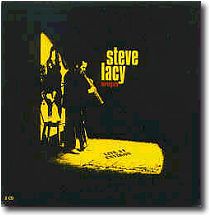 Listen
to the way he wears out his soprano in Snips,
a solo performance recorded live in New York in
1976. Listen
to the way he wears out his soprano in Snips,
a solo performance recorded live in New York in
1976.
Snips
MP3 176KB ( ) )
Impressing, fascinating,
I'm wordless: listening to Lacy in a solo performance is a "no limits"
experience.
But the most interesting thing is that this performance comes a long time
before the record he made with Gil Evans (Paris Blues)
we heard at the beginning
and which is pervaded by a totally different atmosphere.
It may seem a contradiction but it isn't.
Being consistent does
non mean playing in the same style and using only one language but playing
everything with everyone with the same intellectual honesty and the same
creative force.
If you take a look at his boundless discography you will find out that
Lacy has played with the most diverse musicians from Joe Puma to
Roswell Rudd, from Miles Davis to Cecil Taylor, from Gil
Evans to Tadd Dameron, from Albert Mangelsdorff to Phil
Woods, and then Alvin Curran, Enrico Rava, Misha Mengelberg
and many many others.
At this point, someone
might ask the classical question that comes to mind when talking about (more or
less) free musicians: can he play on the chords or does he play like this
because he can’t do anything better?
A hideous as well as useless question, if only because in order to be
able to play what you have just heard you need an awesome knowledge of your
instrument.
The only problem is whether a musician can communicate something or he
can't.
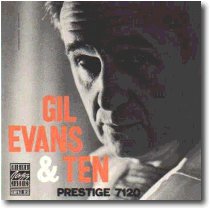 However,
in the case of Steve Lacy the question is even more out of place and to prove it
let’s hear one of his first recordings with Gil Evans. However,
in the case of Steve Lacy the question is even more out of place and to prove it
let’s hear one of his first recordings with Gil Evans.
From "Gil Evans and
Ten" (Prestige 7120
1957),
listen to
Just One of Those Things
of which I will also
provide a transcription, contradicting what I said in a previous article
(I am not as consistent as Steve!)
Just
one of Those Things MP3 448KB ( ) )
Trascrizione
(fai click sui numeri
di pagina per visualizzare lo spartito disponibile in Bb, C e Eb):
pag. 1
2
3
4 (Bb) pag. 1
2
3
4
(C) pag. 1
2
3
4
(Eb)
What a swing, folks!
From this recording, young Lacy already shows a certain tendency to
break up the rhythm, to interplay in a very interesting, swinging way with the
rhythmic section and then to abandon himself to long phrases interrupted by very
high and effective notes.
Evans' arrangement is great, as usual.
The first time you listen to it, you could not fully appreciate Lacy’s
music.
You don't necessarily have to like it but, if you take my advice, try
again, because, if we are used to bop and Coltrane, it takes a little time
before we get rid of our expectations, especially the first time.
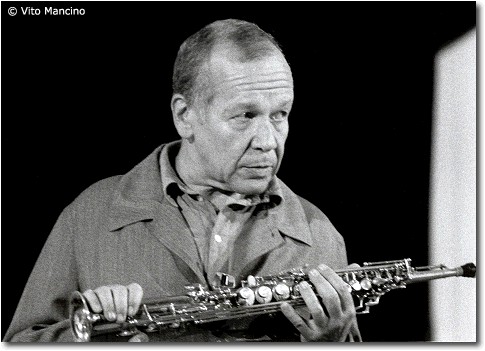 For
me, listening to Lacy means keeping in touch with the essence of music and music
making, that is to say with non stereotyped creativity. For
me, listening to Lacy means keeping in touch with the essence of music and music
making, that is to say with non stereotyped creativity.
I need this never to forget that a different view of music exists, that a
different way of improvising can exist.
I need this to remember to play fewer notes, to emphasize the long ones,
to pay attention to the timbre of my instrument, to dare something different ,
to try, I said try, non to sound like anyone else.
It's a bit like taking a lesson from a guru, who brings you back to the
straight and narrow path, or like going to confession on Sunday. It can be
useful every now and then.
My way of playing the soprano does not sound like Lacy’s, I don’t even
try to sound like him, because he is unreachable and because I don’t think like
him. But nevertheless, every time I listen to him I get new ideas and feel a
great admiration. So, maybe, little by little, a bit of his musical style will
enter my phrasing (until there’s life there’s hope).
I hope this will happen to you too and that this modest contribution of
mine will make someone want to know more about this extraordinary musician.
Fabio
Some links:
http://senators.free.fr/
Steve Lacy’s official site, with photos, audio and video-clips and various
pieces of information, also about his book on the soprano technique illustrated
by his own performances (a present I'll soon buy myself)
http://www.wnur.org/jazz/artists/lacy.steve/discog.html
his boundless discography
http://www.downbeat.com/sections/artists/text/photo.asp?from=&id1=7710
a collection of photos and his biography.
http://www.allaboutjazz.com/bios/slbio.htm
another biography
Insert a comment
©
2000-2002 Jazzitalia.net - Fabio Tullio - All rights reserved
|
© 2000 - 2025 All the material published on Jazzitalia is exclusively owned by the author. Moreover it is protected by International Copyright, so it is forbidden any use of it which isn't authorised by the rights' owner.
|
This page has 8.722 hits
Last Modified Date: 20/03/2006

|
|

